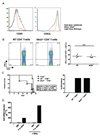Experimental cerebral malaria progresses independently of the Nlrp3 inflammasome
- PMID: 19950187
- PMCID: PMC2837133
- DOI: 10.1002/eji.200939996
Experimental cerebral malaria progresses independently of the Nlrp3 inflammasome
Abstract
Cerebral malaria is the most severe complication of Plasmodium falciparum infection in humans and the pathogenesis is still unclear. Using the P. berghei ANKA infection model of mice, we investigated a potential involvement of Nlrp3 and the inflammasome in the pathogenesis of cerebral malaria. Nlrp3 mRNA expression was upregulated in brain endothelial cells after exposure to P. berghei ANKA. Although beta-hematin, a synthetic compound of the parasites heme polymer hemozoin, induced the release of IL-1beta in macrophages through Nlrp3, we did not obtain evidence for a role of IL-1beta in vivo. Nlrp3 knock-out mice displayed a delayed onset of cerebral malaria; however, mice deficient in caspase-1, the adaptor protein ASC or the IL-1 receptor succumbed as WT mice. These results indicate that the role of Nlrp3 in experimental cerebral malaria is independent of the inflammasome and the IL-1 receptor pathway.
Conflict of interest statement
The authors declare no financial or commercial conflict of interest.
Figures



References
-
- Miller LH, Baruch DI, Marsh K, Doumbo OK. The pathogenic basis of malaria. Nature. 2002;415:673–679. - PubMed
-
- Schofield L, Grau GE. Immunological processes in malaria pathogenesis. Nat. Rev. Immunol. 2005;5:722–735. - PubMed
-
- Potter S, Chan-Ling T, Ball HJ, Mansour H, Mitchell A, Maluish L, Hunt NH. Perforin mediated apoptosis of cerebral microvascular endothelial cells during experimental cerebral malaria. Int. J. Parasitol. 2006;36:485–496. - PubMed
-
- Scholl PF, Tripathi AK, Sullivan DJ. Bioavailable iron and heme metabolism in Plasmodium falciparum. Curr. Top. Microbiol. Immunol. 2005;295:293–324. - PubMed
Publication types
MeSH terms
Substances
Grants and funding
LinkOut - more resources
Full Text Sources
Molecular Biology Databases
Miscellaneous

